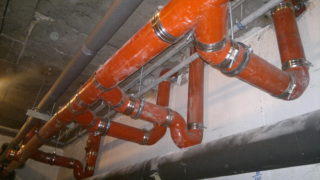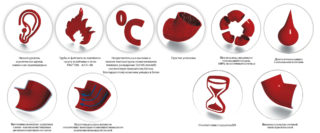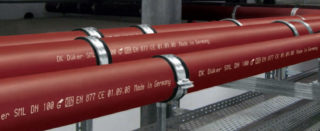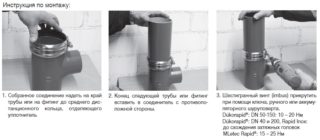The use of cast-iron socketless sewer pipes is important when installing a sewer collector of various types - from central to private. Such elements are joined using special steel clamps and rubber seals. Thanks to this connection, the replacement of the emergency section of the collector is much easier.
Scope of socketless sewage

Cast iron socketless tubes are used when creating such highways:
- sewers from residential and industrial premises;
- system for drainage of storm water from bridges, autobahns;
- collectors for the transportation of aggressive waste from large industrial enterprises;
- the device of the inner part of the sewage system.
Such tubes are produced by centrifugal casting using finely dispersed graphite. As a result, elements with a smooth inner surface are obtained, on which drains are not silted up.
Types of socketless pipes
- Internal elements. With their help, collectors are laid inside residential buildings, restaurants, hotels, hospitals. The most popular are the Duker SML tubes (SML products for installing a collector inside a building).
- Outdoor. Here, the elements are used to drain wastewater from bridges (BML) and to transport sewage through an underground collector (TML tubes).
Without fail, each type of cast-iron tubes is used strictly for its intended purpose, without the possibility of interchanging one of their types with another.
Specifications
According to Russian GOST 6942-98 or European DIN 19522 / EN 877, all socketless elements for collectors have a single length - 3 m. The cross-section of tubes varies from 50 to 300 mm. Tubes with a cross section of 70, 80, 100 mm are provided in the range between 50 and 125 mm in diameter.
After 125 mm, the gradation of sections is 50 mm, that is, pipes with a diameter of 150, 200, 250 and 300 mm are commercially available.
Advantages and disadvantages

The main advantages of cast-iron socketless sewer elements are:
- inertness of the metal to the combustion / melting temperature;
- resistance of cast iron to low temperatures;
- environmental friendliness of the material (metal does not emit harmful substances into the soil / atmosphere);
- corrosion resistance due to the inner layer of epoxy resin and fine graphite;
- optimal tightness of socketless connection;
- no need for expansion joints in the manifold (tubes can withstand pressure up to 10 bar);
- high tensile strength / tensile strength;
- the quietness of the cast-iron sewer system, achieved by the internal coating of epoxy resin with graphite;
- ease of cutting the material if it is necessary to change the length of the pipe;
- uniformity of cast iron thickness along the entire length of the product;
- the smoothness of the inner walls of the sewer elements, which means good sliding of drains along the sewer;
- no need for additional insulation of the system;
- simplicity when carrying out repair work on one of the sections of the collector.
The disadvantages of cast-iron socketless tubes include only the relative fragility of the material. The sewerage element can burst in severe frost with a point mechanical effect of medium strength.
Installation features
- It is forbidden to cut cast iron elements with a gas burner. To cut them, use a hacksaw for metal or a grinder with special discs.
- Pipe cutting is carried out strictly at an angle of 90 degrees with respect to the axis of the element. This even cut ensures further collector tightness.
- It is forbidden to cook pipes. The manifold is connected only with clamps and seals.
- The clamp is fixed using a wrench.
In general, the installation of the system looks like the process of joining one element with another. The tight fit of the two sections of the collector is ensured by an internal stop at one end of the pipe. The joints of the two tubes are covered with a special seal and tightened with a steel clamp. It is produced with one screw (Rapid), or with two (CV). Clamps with sound absorption effect are also commercially available. It is customary to use them in those places of the collector that pass through the floors in the room.
All cast iron pipes that have defects in the form of chips, dents, cracks are prohibited for use. The joints of two tubes do not need to be additionally treated with a sealant. Elastic seals fulfill this function in full.










